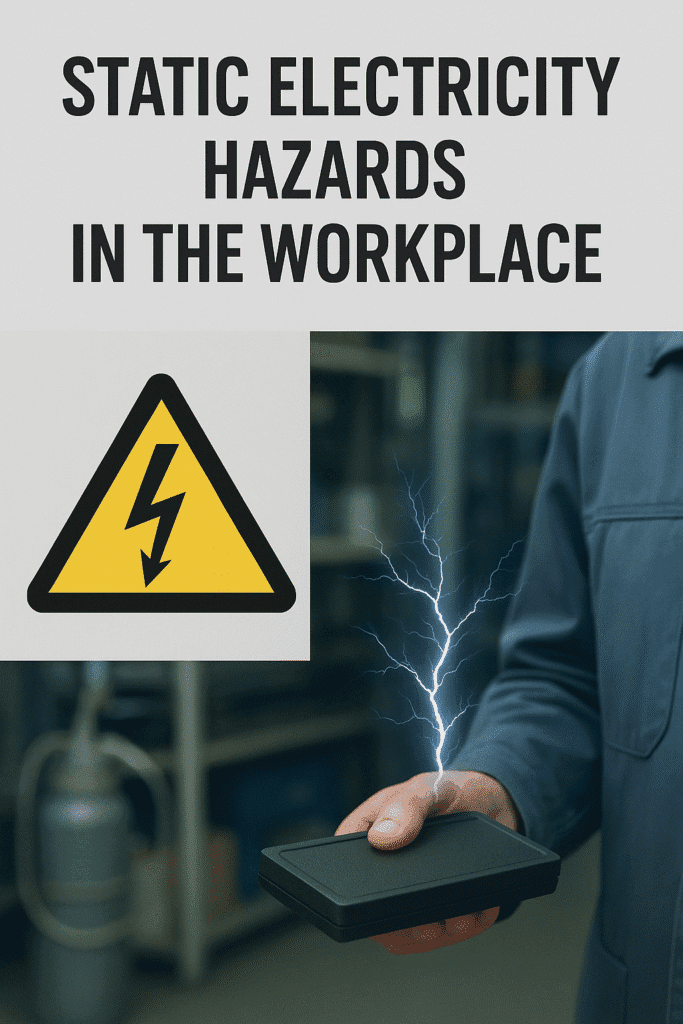
Static Electricity Hazards in the Workplace
Introduction to Static Electricity
Static electricity might sound like a high school science project, but in the workplace, it can be downright dangerous. From igniting flammable vapors to damaging sensitive electronics, static electricity is an invisible threat that demands attention.
What Is Static Electricity?
Static electricity is the buildup of electric charge on the surface of materials. This happens when two surfaces rub against each other, causing electrons to transfer from one surface to another.
Why Static Electricity is Dangerous in the Workplace
That tiny shock you feel after walking on carpet? Imagine that spark occurring near a drum of flammable solvent. Boom! Static can ignite fires, cause explosions, and seriously injure workers.
Understanding the Science Behind Static Electricity
How Static Charges Are Created
Friction is the main culprit—when two objects rub, electrons jump from one to the other. Insulators like plastics are more prone to holding onto these charges.
Common Materials That Generate Static
- Plastics
- Rubber soles
- Synthetic clothing
- Conveyor belts
Discharge and Its Effects
A discharge is the release of built-up static. It can create sparks strong enough to ignite gases, damage electronics, or even give workers a painful jolt.
Industries Most at Risk
Chemical Plants
With volatile solvents and gases everywhere, one spark can lead to disaster.
Oil and Gas Facilities
Static is a known ignition source in tanker loading, fuel transfer, and vapor-handling operations.
Manufacturing and Electronics
Sensitive circuits can be fried with even the smallest static discharge.
Warehousing and Packaging
Friction from plastic wrap, packaging materials, and conveyor belts is a common static generator.
Real-Life Accidents Due to Static Electricity
Famous Case Studies
- A fire in a paint manufacturing unit triggered by static during solvent mixing.
- A grain silo explosion due to static from conveyor belts.
Lessons Learned
- Grounding systems were missing or poorly maintained.
- Workers were unaware of static risks.
Common Workplace Activities That Generate Static
- Walking across synthetic carpets
- Filling drums with flammable liquids
- Removing plastic wraps from pallets
- Using high-speed conveyors or blowers
Hazards of Static Electricity
Fire Hazards
One spark in a flammable environment is all it takes.
Explosion Risks
In dust-heavy or vapor-rich workplaces, static can trigger catastrophic explosions.
Equipment Damage
Electrostatic discharge (ESD) can destroy semiconductors and precision equipment.
Personnel Safety Issues
Shocks can startle workers, leading to slips, trips, and falls—or worse, dropping flammable items.
How to Identify Static Electricity Risks
Workplace Risk Assessment
Identify high-friction processes, presence of flammable substances, and use of insulative materials.
Using Static Meters
Measure charge levels on surfaces or workers.
Conducting Visual Inspections
Look for missing grounding wires or worn-out ESD mats.
Static Electricity Control Measures
Grounding and Bonding
All conductive equipment and containers should be properly grounded.
Humidity Control
Dry air = high static. Maintaining 40-60% humidity can help.
Antistatic Materials and Clothing
Use conductive or dissipative materials in flooring, furniture, and clothing.
Static Dissipative Floors and Mats
Place these in high-risk areas like server rooms or around flammable chemicals.
Personal Protective Equipment (PPE) for Static Control
Antistatic Footwear
Shoes with conductive soles help drain static charges.
Conductive Gloves
Useful when handling sensitive electronics or volatile chemicals.
Flame-Resistant Clothing
Protects workers in case a static spark leads to a fire.
Engineering Controls to Reduce Static Build-Up
Ionizers and Neutralizers
These devices balance charges in the air and on surfaces.
Conductive Brushes and Wipes
Great for sensitive electronics or packaging operations.
Safe Work Practices
Training and Awareness Programs
Everyone should know how static is generated and controlled.
Handling Flammable Liquids Safely
Always use grounded containers and slow-fill techniques.
Regular Equipment Maintenance
Ensure grounding connections are intact and ESD systems are functioning.
Legal and Regulatory Standards
OSHA Guidelines
OSHA recommends static control in explosive environments (29 CFR 1910).
NFPA and IEC Standards
- NFPA 77: Recommended Practice on Static Electricity
- IEC 61340: Electrostatics standards for industrial environments
Training Employees on Static Hazards
Induction and Refresher Training
Include static risks during onboarding and yearly training.
Mock Drills and Emergency Response
Train employees to act swiftly during a static-triggered fire or explosion.
Emergency Procedures
Fire Response Protocols
Use Class B fire extinguishers and isolate energy sources quickly.
Spill and Explosion Preparedness
Have SOPs for handling flammable spills and evacuating during explosions.
Conclusion
Static electricity may be invisible, but its consequences can be massive. From fires to fatal explosions, it poses real threats in many workplaces. The good news? With proper training, grounding, equipment, and vigilance, these hazards can be minimized or even eliminated.
Earth Leakage Protection: ELCB vs RCD vs RCBO
GFCI vs RCCB vs ELCB – Key Differences and Applications
Electrical Safety Interview: 50 Questions and Sample Answers
FAQs
Q1: Can static electricity really cause explosions?
Yes! In environments with flammable vapors or dust, a tiny static spark can trigger massive explosions.
Q2: How can I prevent static buildup in my workplace?
Implement grounding, use antistatic materials, control humidity, and provide PPE.
Q3: What are the most common industries affected by static electricity?
Chemical, oil and gas, electronics, packaging, and manufacturing.
Q4: Are there any regulations requiring static control?
Yes. OSHA, NFPA, and IEC have specific standards related to static hazards.
Q5: Is static electricity dangerous only around flammable materials?
Not at all. It can also damage sensitive equipment and cause minor but harmful shocks to workers.
How to get courses